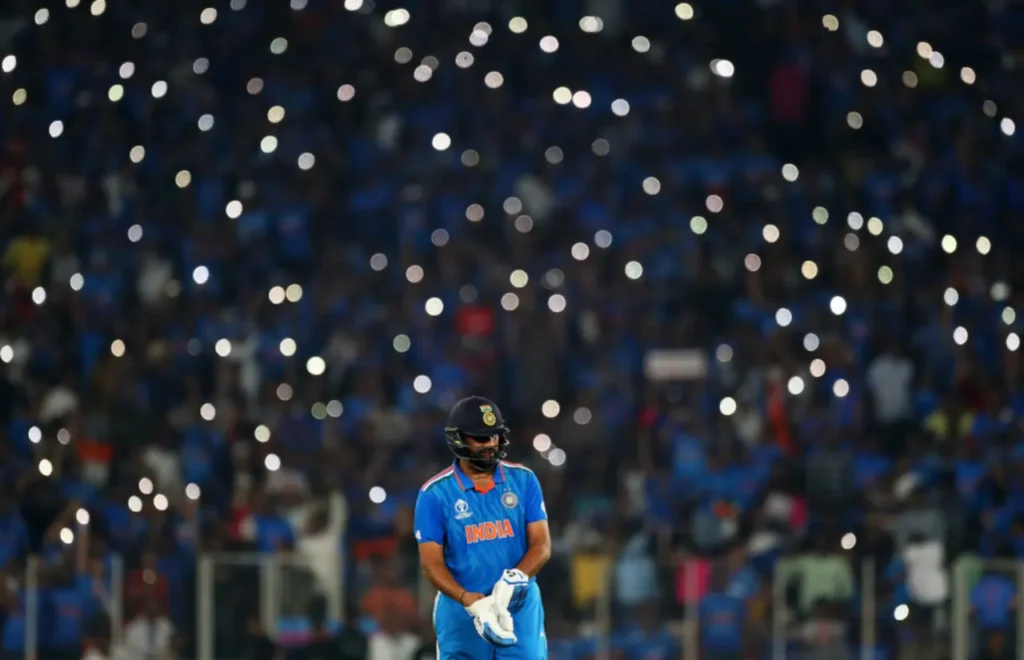
In the world of ODI cricket, where the limelight typically shifts towards the World Cup, it’s easy for transformative performances to fade into the background. Yet, under the calm and collected leadership of Rohit Sharma, India’s ODI strategy has undergone a radical transformation. This deep dive attempts to peel back the layers and understand the ‘Rohit Sharma Phenomenon’.
The Stage: World Cup Revelations
The World Cup – a platform where heroes are made, and legends remembered. Rohit Sharma, after a hiccup against Australia, quickly rectified his course, making waves against Afghanistan and Pakistan. With scores of 76 off 43 balls and 45 off 30 balls, Rohit’s dynamic innings were no fluke, rather a glimpse into a calculated shift in mindset.
Rohit’s Batting Transformation: By The Numbers
From Conservatism to Aggression: Rohit’s ODI journey has seen a spectrum shift from his initial games. His early-career mantra revolved around anchoring the innings, playing cautiously at the start, and then going big towards the end. This philosophy, however, has seen a dramatic shift.
Statistical Analysis
| Year | Balls Faced | Runs | Strike Rate |
| 2018 | 1234 | 1024 | 83.01 |
| 2019 | 1189 | 1090 | 91.75 |
| 2022 | 954 | 1065 | 111.73 |
| 2023 (upto WC) | 625 | 800 | 128.00 |
From the table, it’s evident how Rohit has minimized the balls faced while maximizing runs, indicating his transition to a more aggressive approach.

Historical Perspective: Breaking Chains of Conventionalism
Rarely do team captains, who bear the weight of an entire nation’s expectations, stray from the established norms. Yet, there have been exceptions:
- Brendon McCullum (2015): Known for his aggressive approach, he had a strike rate of 163 in the first ten overs.
- Chris Gayle (2009): Another stalwart, with a rate of 117 in the initial overs.
What’s truly astounding is Rohit’s deviation from his own tried-and-tested methodology. Persisting through initial failures, he’s emerged as a modern ODI behemoth.
Unpacking the Catalysts
The turning point can be traced back to the T20Is, where India’s somewhat traditional batting approach was starting to appear dated. This raised eyebrows and led to introspection.
- New Management’s Role: With fresh faces in the coaching staff and management, the emphasis on a renewed strategy grew. Their influence, combined with Rohit’s open-mindedness, paved the way for change.
- Leading from the Front: Rohit’s realization was crystal clear: to inspire a team towards a new direction, the leader must first embody the change.
Impact Analysis: India’s Strategic Makeover
An aggressive captain often influences the overall team strategy. India’s ODI run rates over the years are a testament to Rohit’s impact.
| Year | Team Run Rate |
| 2019 | 4.44 |
| 2022 | 4.83 |
| 2023 | 6.27 |
The rising run rates hint at a more aggressive, fearless brand of cricket, undeterred by failures or setbacks.
Decoding the Game Plan
India, often known for its strategic secrecy, has left fans and analysts guessing about the underlying game plan. A few speculated reasons include:
- Eliminating Complicated Chases: By scoring big and scoring fast, India aims to eliminate the risk of tricky chases, making victories more straightforward.
- Empowering the Middle Order: Rohit’s approach ensures that the middle order isn’t just confined to damage control, but can play their natural game without excessive pressure.
- Leading by Example: This aggressive mindset, when demonstrated by the captain, naturally trickles down, setting a tone for the entire team.
Conclusion: A New Dawn for Indian Cricket?
Rohit Sharma’s transformation is not just personal but represents a broader shift in India’s cricketing philosophy. From a country known for its textbook cricketing shots, India under Rohit’s leadership is painting a new canvas – one filled with audacity, aggression, and ambition. The only question that remains: Will this bold strategy be the key to India’s future successes? Only time will tell. But for now, fans and experts alike are hooked, waiting to witness the next chapter in this riveting saga.































